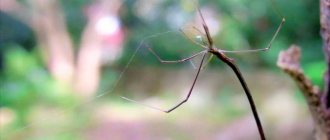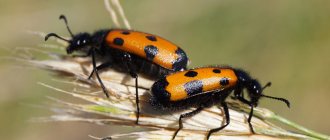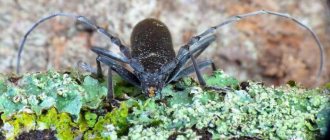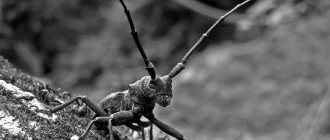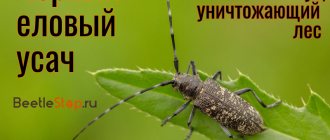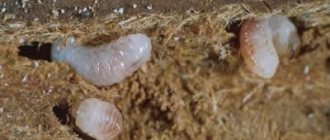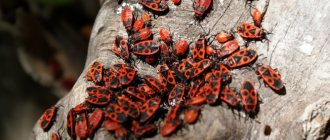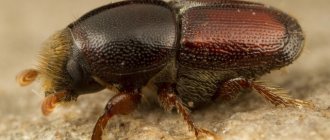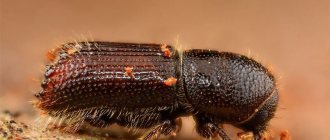The Great Oak Longhorned Beetle is one of the most beautiful and largest woodcutter beetles, with Mediterranean roots. The insect can be found in European countries and Africa. It is also widespread throughout our country, in Belarus, Ukraine and the Caucasus. The longhorned beetle has become popular not only because of its large size (its body length can reach up to 6.5 cm), the insect is one of the most dangerous pests of oak wood. This article will tell you who the oak longhorn beetle is, or as it is also called the black oak longhorned beetle.
Peculiarities
The large oak longhorned beetle is a fairly large beetle whose body has a shiny black-resin color. A special feature of this type of longhorned beetle is its mustache. They are as silky to the touch as the abdomen of an insect. In females, their size corresponds to the length of the body, while in males they are much longer. The first segment of the whiskers is almost matte, as it has a densely applied dotted line. The length and width of the second segment are approximately comparable.
The elytra have a smooth surface, and only their apex is covered with red-red hair. There are two pairs of spines on the wrinkled pronotum. Below you can see what the oak longhorned beetle looks like in the photo.
Oak longhorned beetle
How to protect oak plantings
Although the appearance of the oak longhorned beetle is rare, preventative measures should be taken to help protect plantings from insects. To prevent the appearance of a pest, you must:
- carry out clear and selective sanitary felling in a timely manner;
- regularly inspect the condition of trees;
Large barbel on an oak tree.
- clean logging sites, sample dead forests and fallen trees;
- remove newly populated and dying trees;
- attract birds that feed on insects;
- plan final fellings.
Lifestyle
Large oak longhorn beetles emerge from their secluded hiding places at the end of May. They are especially active at the beginning of summer, preferring to fly during the daytime. Their favorite habitats include isolated trees or oak forests.
Interesting!
More often, insects settle on trees that secrete a special liquid - gum, which they like to feast on. Having settled in the wood of a tree, the beetles gnaw long tunnels in it, which causes the plant to “cry” (secrete sap).
Much less often, large oak longhorn beetles can be found on walnut or apple trees. They do not have much love for ash, hawthorn and hazel.
Enemies of the insect
In nature, the oak barbel has many enemies. The woodpecker is considered especially dangerous because it feasts on beetle larvae living in wood. Some insects belonging to the order Hymenoptera (for example, encyrtids) can parasitize beetle eggs. Some species of predatory beetles prey on longhorned beetle larvae:
- toddler;
- nutcracker;
- moth
Reproduction
Despite the fact that the large oak longhorned beetle lives for about 3 months, the female manages to lay about a hundred eggs during this period. She looks for a place to lay eggs with the help of her mustache, which serves as her sense of smell (males use their mustache to find a partner). When choosing a tree that serves as a home and source of food for longhorned beetles, insects examine its condition. More often, beetles settle in dead or rotting wood. But they can also choose a healthy tree, which causes damage to humans.
Lifestyle of a beetle
Usually the female makes a cradle for her future offspring in cracks in the tree bark. Old oaks, hornbeams, elms or beeches are especially suitable for this. After 15 days, larvae emerge from the eggs and develop for more than two years. The photo and description of the larva of the large oak longhorned beetle is not much different from the larvae of its relatives. This is a fairly large white or yellowish creature that develops at a slow pace. A two-year larva grows up to 5-6 cm, after another year it can grow up to 9-10 cm, and in diameter - up to 2 cm.
On the small, brown-red head of the larva there are 3 eyes and powerful jaws. It moves along the passages gnawed in the wood with the help of abdominal and dorsal growths, which are also called calluses. Before the pupation period begins, the larva gnaws a tunnel in the tree, the length of which can reach 1 meter. At the end of such a move, the larva drills an oval hole, which serves as a bedroom for the future pupa. From this shelter she makes another tunnel, through which in the future an adult large oak longhorned beetle will emerge. In the meantime, the larva covers it with particles of bark and wood fibers.
On a note!
The process of formation and growth of the large oak longhorn beetle, from egg to adult, lasts about four years (depending on habitat conditions and weather).
Description of an insect in the larval stage
The beetle larvae are quite large in size: length is about 90 mm, and thickness is from 17 to 22 mm. The body is colored yellow-white or cream. The head is brownish-red in color and has three eyes. The larva has very powerful jaws; they are painted black. The chest part is very wide, and the back is covered with chitin. The growths located on the back and abdomen help in the movement of the larva along the passages and holes made in the tree.
What harm does
The large oak longhorn beetle is one of the most dangerous wood pests. The damage it causes to the tree is already obvious after the beetle larvae reach one year of age. When there is a large concentration of insects, the color of the foliage and its condition changes, it becomes withered. Young shoots also dry out, which hinders the growth and development of the plant. Therefore, it is advisable to get rid of the pest. Damaged wood can subsequently only be used as firewood.
Therefore, in the old days, when a large population of beetles was discovered in an oak forest, they tried to quickly get rid of the infected stands by uprooting or sanding all the remaining oak stumps. However, these days there are not so many perennial oak forests left, and the formerly large mustachioed pest has become no less a rarity. In connection with which it was even included in the Red Book.
A little bit of biology
Longhorned beetles have fairly small sizes (from one to several tens of millimeters), a flat body and mustaches, which are the main organ of smell.
The color of lumberjacks is usually brown or dirty gray; less commonly, the longhorn beetle is black. The photo allows you to examine the insect in more detail. The larvae of the pest are characterized by particularly powerful jaws, thanks to which they can handle both hard wood and soft metal with a cable-type coating. However, the beetles do not eat the latter so readily, preferring wooden structures and stacked boards.
The female barbel lays her eggs (from 200 to 400 pieces) in recesses or cracks in the tree, and after 7-14 days the larvae are born, which instantly activate the process of destroying the tree.
It is worth emphasizing that it is almost impossible to immediately notice a tree disease, since the larvae lead a hidden lifestyle. So, you can understand that your wooden house has succumbed to the harmful effects of longhorned beetles only when the real results of their work (destroyed and loosening wood) are visible.
Black forest ants and their larvae
In the forest you can often find anthills, and ants live in them. Ants are an excellent food for the “starving prepper.” They contain a lot of protein. Ants contain formic acid, which is easily, almost completely neutralized during heat treatment (cooking). Red ants are very acidic (they contain a lot of formic acid).
How to cook:
- Ant broth
- Roasting ants
- Eat raw
Ant eggs
Ant eggs are a light food that is very easy to collect. They are very nutritious and contain a lot of protein. There is one simple way to collect ant eggs.
We dig up an anthill from the side (or at least from above). We scatter the contents of the anthill onto a cloth (you can use an awning or a jacket), and wrap the edges. Be sure to spread (fabric, jacket) so that direct sunlight falls on it. To avoid the eggs and larvae from drying out, the ants begin to drag them into the shade (under the folds of fabric or jackets). This way we get a lot of nutritious and clean (without soil and garbage) product.
The best insecticides
Let's look at several substances for combating beetles that have proven themselves to be effective.
Dr.Klaus
An effective, domestically produced product that costs around 1,000 rubles. Available in liter bottles with a syringe nozzle, with which the liquid is conveniently poured into the inlet holes.
The main active ingredient is lambda-cyhalothrin. It is an effective insecticide against most types of insect pests. Lambda-cyhalothrin not only kills them, but also has a good repellent effect.
"Clipper"
An effective domestic drug. The product is expensive - it costs about 3,000 rubles. Available in 1 liter bottles that do not have a dispenser.
The main active ingredient is bifethrin. It disrupts sodium metabolism in the body of most insect species, which leads to their death.
Bifethrin negatively affects not only invertebrates, but also birds, mammals, and reptiles. Therefore, people and pets must be removed from the treatment site. It is mandatory to use personal protective equipment (respirator mask, gloves).
"Calypso"
Inexpensive insecticide for treating garden trees from. The cost depends on the concentration and volume and starts from 60 rubles per bottle.
The drug is based on thiacloprid. This substance affects the insect's nervous system, causing convulsions and paralysis.
The main advantage of "Calypso" is its versatility. The drug affects not only the bark beetle, but also other pests (ants, aphids, mites).
Bi-58
Expensive but effective insecticide. Sold in 10 liter cans. One will cost 5,000 – 6,000 rubles.
The main active ingredient is dimethoate. It affects the nervous system of insects and inhibits respiratory activity, which leads to the death of the pest.
Expert opinion Stefania Bogdanovna Mityuk
The drug is very dangerous for people and pets - this must be taken into account during work.
Empire-20
Powerful imported drug. One 30 ml container costs about 500 rubles.
The composition of the product is based on 2 insecticides:
- cypermethrin is a neurotoxin that causes convulsions, paralysis and subsequent death in insects;
- malathion - disrupts the metabolism of pests, promoting the production of poison by their body.
The drug is dissolved in water and the resulting mixture is treated with plants.
The main advantage of Empire-20 is its relative safety for people.
XILIX® Gel fungicide and insecticide in one bottle with a 10-year guarantee!
XILIX® Gel is an innovative development for combating any wood pests such as longhorned beetles, borers, shashel, wood borers, etc. It is also an effective professional biocide that effectively destroys mold, mildew, and copes with wood rot and defects.
Indispensable for the prevention and treatment of wooden structures.
• Destroys termites, borer beetles, bark beetles, wood borers, longhorned beetles, etc. • Economical and easy to use • Safe for people • Strengthens the structure of the wood • Ready to use, the gel does not flow, leaves no traces • Penetrates deeply into the wood
XILIX® Gel is an excellent, safe alternative to phosphine gas fumigation with a 10 YEAR warranty! High efficiency is achieved thanks to properly selected gel components. Biocides and permethrin in the composition give a fantastic insecticidal and fungicidal effect.
Thanks to its thixotropic formulation, the gel works without loss of properties even in a thick layer of wood, thereby reducing the number of applications to obtain the required therapeutic or prophylactic dose of the gel.
Prevention of the appearance of the barbel
Advice:
Of course, it is best to prevent the appearance of the beetle from the very beginning, during the construction stage. There are many ways to do this.
In order to make wood poisonous for the long-horned beetle, it must be impregnated with a special agent - for example, Clipper solution, a fairly inexpensive and effective drug, or any other long-acting insecticide - League Bioprotection or Neomid 440. It is also necessary to monitor the moisture content of the wood - dry wood is less attractive to longhorned beetles. All cracks and chips must be covered with putty - this way the beetles will not have a place to lay. It is also recommended to treat exposed surfaces with drying oil.
The highest risk of damage is for newly built wooden houses in the first five years after construction, when the wood has not yet dried out properly. At this time, you need to monitor the condition of the wooden elements of the building especially carefully and treat them more often than usual. In the future, preventive treatment of wooden parts can be carried out every few years.
As a preventative measure, it is recommended to treat wooden furniture with a mixture of turpentine, melted paraffin and creolin in a ratio of 10:5:3. This treatment will make the wood inedible for the larvae, and at the same time it will clog the cracks and crevices.
Don’t forget about timely inspection and prevention - and unexpected guests won’t bother you!
Preventive measures
The best way to fix a problem is to eliminate its causes. The appearance of a grinder is a very dangerous signal. He talks not only about the threat to house structures and buildings, but also about the possibility of damage to garden plants. Therefore, it is necessary to cut off all ways of insects entering the area.
Most often they come from lumber brought from an infected sawmill or trading base.
To protect against the grinder, you should inspect the material, paying special attention to defective areas of the boards (presence of bark, dead parts). If affected boards or timber are found, it is recommended to refuse the purchase and look elsewhere. What products do you use to deal with the beetle grinder?
What products do you use to deal with the beetle grinder?
FolkChemical
Experts say that completely eliminating the borer is extremely difficult, if possible at all. Therefore, the processing procedure should be repeated periodically. If possible, affected structural elements should be replaced with new, clean parts. This will prevent the spread of insects and damage to garden plants.
The appearance of a beetle grinder cannot be detected immediately. Therefore, it is necessary to take action immediately. It is unknown how far the insects have spread inside wooden parts or structures, or how many trees they have managed to inhabit.
It is recommended to immediately carry out a thorough inspection, examine the most critical areas and carry out treatment. If you have no experience, the best solution would be to contact a specialized company or SES. The participation of specialists will help solve the problem in the most effective way.
Features
The following signs may indicate that there is a longhorned beetle in the house:
- the presence of small holes and passages on the surface of the wood;
- rustling, clicking and ticking - these are the characteristic sounds that longhorned beetles make when gnawing passages in the wood of a house;
- brown or yellowish powder (drill flour);
- the presence of pests themselves flying around the house.
Therefore, if you detect the listed symptoms, it will not be superfluous to know how to get rid of the longhorned beetle in a wooden house.
- Long mustache. The longhorned beetle has prominent whiskers that are 2-5 times longer than the insect itself.
– Slender and elongated body. The length of the body varies from 3 to 60 mm.
- Wings. Some species of woodcutter beetles can fly.
- Hair.
Behavior
The oak longhorned beetle is a sedentary insect. It makes its flights at night and only over short distances. It is almost impossible to see it during the day. Usually the flight of the barbel occurs in order to find a new food tree.
The beetle feeds on leaves and juice flowing from damaged areas.
To get its juice, it gnaws through a tree with its large jaws. The favorite trees of the longhorned beetle include sessile and common oak. It can also be seen on walnuts, chestnuts, elms and beeches.
Natural enemies are all insectivorous birds. An alarmed barbel makes creaking sounds, rubbing its wings against the pronotum.
Spreading
The oak barbel inhabits all of Europe and a small part of South-West Asia. Its habitat covers the territory from Saudi Arabia to the Mediterranean Sea and to the south of Sweden, from France to Western Ukraine. The insect can often be seen in the Caucasus.
The beetle has perfectly adapted to temperate climates and is able to withstand severe frosts. Despite its wide habitat, its colonies can only be observed where there is a sufficient food supply. Insects love places warmed by the sun and prefer unshaded trees.
Professionals will help you fight the longhorned beetle
To treat the external surface of a wooden house with Clipper, you can invite a specialist with a cold or hot fog generator. This treatment allows you to evenly cover the entire treated surface with drops of insecticide, spending less time on it and saving on consumables.
Be wary of the proposal to treat your house against insect pests with a combination of Clipper and Bi-58. The poisonous drug Bi-58 is a bright blue liquid containing phosphoric acid esters, which leaves irremovable stains and an ineradicable chemical odor after its use. It is strictly forbidden to use this drug for treating interior spaces.
In the market for services offered by professionals for the destruction of wood-eating insects, the following areas deserve attention:
- Fumigation with Phosphine;
- Microwave disinsection.
- XILIX GEL
These methods have their advantages and disadvantages. They can only be used by specialists who have undergone special training, confirmed by the appropriate certificate.
Related species Monochamus urussovi
The Eurasian species of longhorned beetle is similar in appearance to its counterparts living on spruce. The beetles live on trees of the pine family, but prefer fir trees. The species is widespread in dark coniferous forests of Russia, northern Asia and Europe. The eastern border of distribution reaches Korea and Japan. The black fir longhorned beetle reaches sizes of 18-37 mm. The body, legs and antennae are black. Females have white hairs on their elytra. It differs from other members of the family in several ways:
- depressed groove at the end of the elytra;
- light hairs on the apex of the elytra;
- granular punctation of the base of the elytra;
- grainy antennae of the male.
The larvae of the spruce and fir black longhorned beetles are similar to each other. They gnaw deep passages and throw sawdust out through the holes.
Notes
- ↑
- ↑
- Striganova B. R., Zakharov A. A.
Five-language dictionary of animal names: Insects (Latin-Russian-English-German-French) / . - M.: RUSSO, 2000. - P. 152. - 1060 copies. — ISBN 5-88721-162-8. - ↑
- ↑ Cherepanov A.I.
Longhorned beetles of Northern Asia (Cerambycinae) / Violovich N.A. - Novosibirsk: “Science”, 1981. - T. II. - pp. 175-179. — 215 p. — 1000 copies. - ↑ Plavilshchikov N.N.
2 // Fauna of the USSR. Coleoptera. Woodcutter beetles / Zernov S. A. - Moscow-Leningrad: Academy of Sciences of the USSR, 1940. - T. XXII. - pp. 507-512. — 785 p. - (22). — 1000 copies. - ↑
- Kostin I. A.
Dendrophagous beetles of Kazakhstan (bark beetles, woodcutters, borers). - Alma-Ata: “Science”, 1973. - P. 242-243. — 287 p. — 1400 copies. - ↑ Identifier of forest pests / Ilyinsky A. I. - Moscow: Selkhozizdat, 1962. - P. 317. - 392 p.
- Key to insects of the Russian Far East. T. IV. Reticuloptera, Scorpioptera, Hymenoptera. Part 5 / under general ed. P. A. Lera. - Vladivostok: Dalnauka, 2007. - P. 675. - 1052 p. — ISBN 978-5-8044-0789-7.
Malicious actions and countermeasures
Changeable weather conditions, disasters and cataclysms make it impossible to regulate the number of harmful beetles. Large and small spruce longhorned beetles thrive in areas that have suffered a fire or attack by Siberian silkworm caterpillars. Among the measures that can reduce the number of harmful insects are the following:
- The use of natural enemies of woodcutting beetles - birds (woodpeckers, swallows).
- Timely sanitary felling of weak trees.
- Preparation of trap trees - special spruce or fir trunks to which the larvae are attracted and then destroyed before they are buried in the wood.
- When a forest area is heavily infested, insecticides are used to help destroy insect pests.
- Fast processing and proper storage of lumber. Unrooted trunks should not be left in clearings for a long time.
Harm from woodcutter beetles
The presence of dangerous beetles can be determined by their characteristic features: notches, drill flour, larvae. If you notice insects, you must report them to the pest control service.
| Summary data | |
| Favorable t (about C) | +25 – +30 |
| Min. t development (about C) | At least +10 |
| Fertility (pcs) | 30 |
| Generations per year | 1 |
| Egg(mm) | 3.5x1.4 |
| Larva (mm) | 40–50 |
| Pupa (mm) | 16–22 |
| Imago (mm) | 11–28 |
Where can I meet you?
The longhorned beetle can live and reproduce not only in various tree species, but also in shrubs and herbaceous plants. Longhorned females lay their eggs in a crack in tree bark, in depressions on branches, trunks or stems. Moreover, the pests make these cracks and gouges themselves.
Lumberjacks can “visit” you at your dacha, and the forestry industry can “boast” of such guests. In country houses, the objects of pest attack are furniture, boards and other wood products.
Phenology
The larva gnaws under the bark and in the wood, and the male larva pupates in the fall in a cradle in the bark, and the female larva gnaws a hooked burrow into the wood and pupates in the spring. Pupation usually occurs in early spring. Beetles fly most often from April - May to June.
With Mediterranean roots. The insect can be found in European countries and Africa. It is also widespread throughout our country, in Belarus, Ukraine and the Caucasus. The longhorned beetle has become popular not only because of its large size (its body length can reach up to 6.5 cm), the insect is one of the most dangerous pests of oak wood. This article will tell you who the oak longhorn beetle is, or as it is also called the black oak longhorned beetle.
